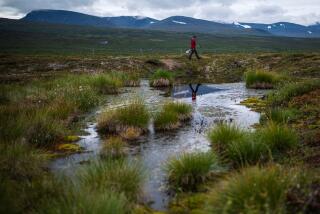Alaskan Glaciers Melting Faster Than Once Thought
- Share via
WASHINGTON — Alaska’s glaciers are melting at more than twice the rate previously assumed because of warming temperatures, a disturbing phenomenon that is dramatically altering the majestic contours of the state and driving up sea levels, according to a new study.
Scientists using highly precise airborne laser measurements of 67 Alaskan glaciers from the mid-1950s to the mid-1990s discovered that the glaciers are melting an average of 6 feet a year--and in some cases a couple hundred feet--and that the rate has accelerated in the last seven or eight years.
“The next question is: What has been causing this glacier thinning? Is it because there is less snowfall in the winter or are the summers warmer?” said Anthony A. Arendt, one of the researchers. “Glacier changes are linked to the climate, so this indicates that something has changed about the Alaskan climate.”
The study by a team of researchers from the University of Alaska in Fairbanks, published in today’s issue of the journal Science, offers a vivid and troubling picture of the potential adverse effect of climate change on the United States and the rest of the world.
As one measure of the severity of the problem, the researchers calculated that the glaciers are generating nearly twice the annual meltage of the Greenland Ice Sheet, the largest ice mass in the Northern Hemisphere and second only to the Antarctic. That would mean the Alaskan melt is adding about .008 of an inch a year to the sea levels, which could have long-term implications for flooding on Pacific islands and along coastal areas, the researchers concluded.
“The change we are seeing is more rapid than any climate change that has happened in the last 10 to 20 centuries,” said Keith Echelmeyer, one of the five researchers who prepared the study.
Scientists can’t say whether the extraordinary melting is the result of man-induced global warming, the slow natural advance and rapid retreat of the glaciers, or dramatic but natural variations in global weather patterns. But the effects are illustrative of what some scientists and environmentalists predict will happen at home and abroad unless the United States and the rest of the world undertake a more aggressive effort to reduce carbon dioxide and other heat-trapping gases.
“We’re getting to the point that this melting is affecting human society,” said Janine Bloomfield, a climate expert with Environmental Defense, a New York-based advocacy group. “Until now, it was just warning signs and signals that the Earth was warming.”
The study has provided fresh evidence for Alaskan officials, researchers and environmentalists who say their state has become the poster child for the ills of global warming. Over the last 30 years alone, the annual mean temperature in Alaska has risen 5.4 degrees--four times the average global increase, according to the University of Alaska’s Center for Global Change and Arctic System Research.
As the state’s pervasive permafrost begins to thaw, the consequences are dramatic and are seen as alarming: sagging roads, crumbling villages, sinking pipelines, the proliferation of insects that are destroying spruce forests and the possible disruption of marine wildlife. Some Alaskans talk about “drunken trees” that list and show their roots because of the rapid decline of the permafrost.
More to Read
Sign up for Essential California
The most important California stories and recommendations in your inbox every morning.
You may occasionally receive promotional content from the Los Angeles Times.













